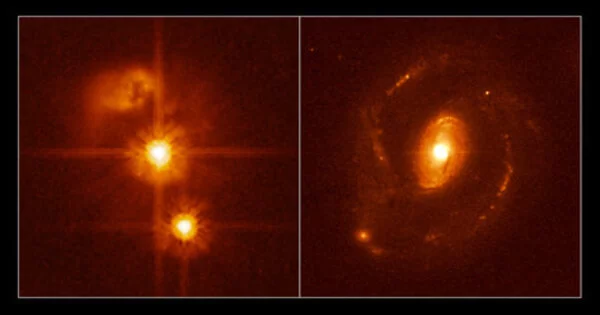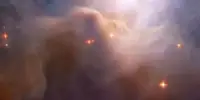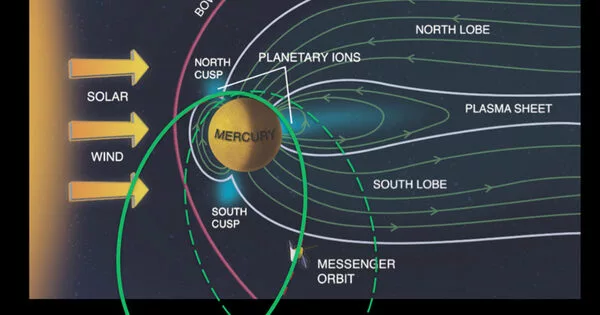A quasar is a very bright and active galactic nucleus that is powered by a supermassive black hole at the center of a galaxy. Double quasars are unusual objects in which two quasars appear to be in close proximity in the sky. The Hubble Space Telescope is an incredible tool for studying the universe in visible, ultraviolet, and near-infrared light. In its nearly 30 years of operation, it has made numerous significant discoveries, including the detection of numerous quasars and other distant objects.
The early universe was a rambunctious place where galaxies frequently collided and even merged. Astronomers investigating these developments used NASA’s Hubble Space Telescope and other space and ground-based observatories to make an unexpected and rare discovery: a pair of gravitationally bound quasars, both blazing away inside two merging galaxies. They existed only 3 billion years ago, when the universe was only 3 billion years old.
Quasars are bright objects powered by voracious, supermassive black holes that erupt ferocious fountains of energy as they devour gas, dust, and anything else in their gravitational grasp.
“We don’t see a lot of double quasars at this early time in the universe. And that’s why this discovery is so exciting,” said graduate student Yu-Ching Chen of the University of Illinois at Urbana-Champaign, lead author of this study.
Hubble’s sensitivity and resolution provided pictures that allow us to rule out other possibilities for what we are seeing. Hubble shows, unequivocally, that this is indeed a genuine pair of supermassive black holes, rather than two images of the same quasar created by a foreground gravitational lens.
Yu-Ching Chen
Finding close binary quasars is a relatively new area of research that has only emerged in the last 10 to 15 years. Today’s powerful new observatories have enabled astronomers to identify instances where two quasars are active at the same time and are close enough to merge.
There is growing evidence that large galaxies form through mergers. Smaller systems combine to form larger systems and ever-larger structures. Within the merging galaxies, pairs of supermassive black holes should form. “Knowing about the progenitor population of black holes will eventually tell us about the emergence of supermassive black holes in the early universe, and how frequent those mergers could be,” Chen explained.
“We’re starting to unveil this tip of the iceberg of the early binary quasar population,” said Xin Liu of the University of Illinois at Urbana-Champaign. “This is the uniqueness of this study. It is actually telling us that this population exists, and now we have a method to identify double quasars that are separated by less than the size of a single galaxy.”

This was a needle-in-a-haystack search that required the combined power of NASA’s Hubble Space Telescope and Hawaii’s W.M. Keck Observatory. The International Gemini Observatory in Hawaii, the National Science Foundation’s Karl G. Jansky Very Large Array in New Mexico, and NASA’s Chandra X-ray Observatory all contributed to a better understanding of the dynamic duo. In addition, the ESA’s Gaia space observatory assisted in identifying this double quasar in the first place.
“Hubble’s sensitivity and resolution provided pictures that allow us to rule out other possibilities for what we are seeing,” said Chen. Hubble shows, unequivocally, that this is indeed a genuine pair of supermassive black holes, rather than two images of the same quasar created by a foreground gravitational lens. And, Hubble shows a tidal feature from the merging of two galaxies, where gravity distorts the shape of the galaxies forming two tails of stars.
However, Hubble’s high resolution is insufficient to search for these dual-light beacons. Gaia, which was launched in 2013, was used by the researchers to identify potential double-quasar candidates. Gaia precisely measures the positions, distances, and motions of nearby celestial objects. However, it can be used to explore the distant universe in a novel way. The vast database of Gaia can be used to look for quasars that mimic the apparent motion of nearby stars. Because they are so close together, the quasars appear as single objects in the Gaia data. Gaia, on the other hand, can detect a subtle, unexpected “jiggle” that mimics an apparent shift in the position of some of the quasars it observes.
In reality, the quasars aren’t moving through space in any measurable way. Instead, their jiggle could be evidence of random fluctuations of light as each member of the quasar pair varies in brightness on timescales of days to months, depending on their black hole’s feeding schedule. This alternating brightness between the quasar pair is similar to seeing a railroad crossing signal from a distance. As the lights on both sides of the stationary signal alternately flash, the sign gives the illusion of “jiggling.”
Another issue is that, because gravity warps space like a funhouse mirror, a nearby galaxy could split the image of a distant quasar into two, giving the impression that it was a binary pair. The Keck telescope was used to ensure that no lensing galaxy was in the way of the suspected double quasar.
This double quasar no longer exists because Hubble looks into the distant past. Over the last 10 billion years, their host galaxies have most likely evolved into giant elliptical galaxies similar to those seen in the local universe today. And the quasars have merged to form a massive, supermassive black hole at its core. M87, a nearby giant elliptical galaxy, contains a monstrous black hole 6.5 billion times the mass of our Sun. Perhaps this black hole was grown from one or more galaxy mergers over the past billions of years.
















